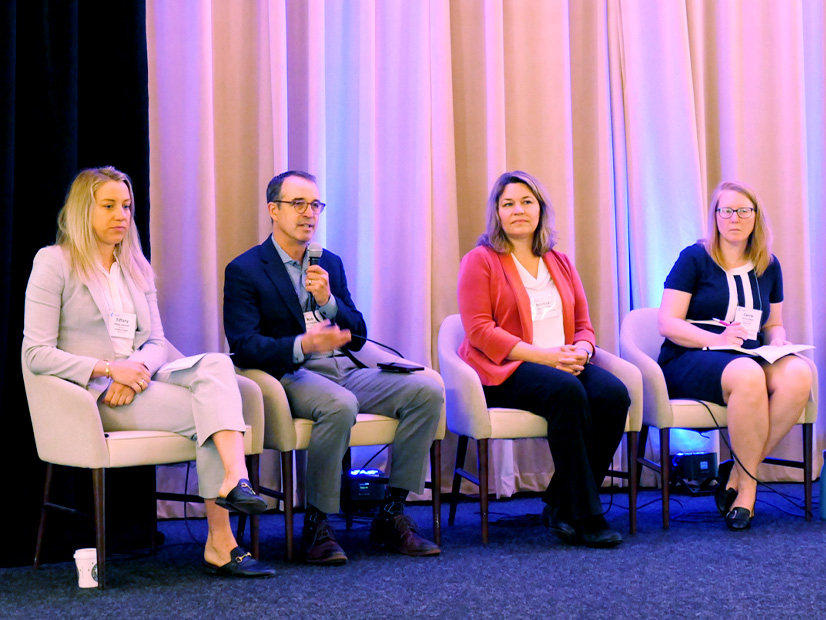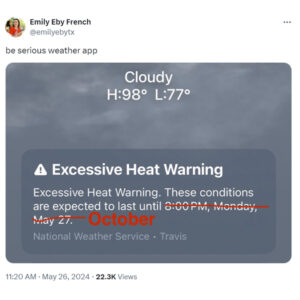CARROLL, N.H. — Angst over looming load growth, cost increases and reliability headaches headlined the 76th annual New England Conference of Public Utilities Commissioners (NECPUC) Symposium, held May 20-21 at the Mount Washington Hotel.
“I think it is a laudable goal to want to get rid of any greenhouse gas-emitting source, but we’re going to have to do this at pace,” said Charles Dickerson, CEO of the Northeast Power Coordinating Council. He said that as policymakers push for “100% reliable, 100% renewable and 100% really cheap [power], I just don’t think those three [aspects] can exist in one space at one time.”
Dickerson called on regulators to work to encourage innovation and be “a little less rigid” around cost recovery for utilities experimenting with new solutions.
“If we take the same approach to regulation that we’ve taken over the past 100 years, it’s probably going to take us 100 years to solve this,” Dickerson said, adding that regulators should try to approach the looming challenges with “a little bit more risk tolerance and a lot more creativity.”
Vineyard Offshore CEO Alicia Barton pushed back with a more optimistic tone.
“Respectfully, I do disagree — actually pretty strongly — that we can’t do all three,” said Barton, former CEO of the New York State Energy Research and Development Authority. She emphasized that changes to the power purchase agreement model, including tweaks to contract lengths and inflation-adjustment mechanisms, could help bring costs down.
“You can actually get better costs if you leverage some of these choices,” Barton said.
Richard Levitan of Levitan & Associates recommended that public utility commissions “embrace principles of transparency, honesty and realism” when weighing competing priorities.
“I don’t think in the pursuit of clean, reliable and affordable [that] there are easy tradeoffs,” Levitan said. “There is no one unassailable answer; there’s no quick solution; but constructive debate with prominent stakeholders — possibly through the ISO, but at the state level too — should inspire awareness, and I think that’s a laudable goal.”
Coping with Increasing Demand
ISO-NE projects that load growth will rapidly accelerate in the coming decades, doubling current peak load levels by 2050. The RTO estimates that the transmission upgrades required to meet this peak will cost in the range of $19 billion to $26 billion. (See ISO-NE Analysis Shows Benefits of Shifting OSW Interconnection Points.)
These upgrades will come on top of increasing costs associated with upgrading and climate-proofing distribution networks and accumulating state PPAs. (See How Sea Level Rise, Coastal Flooding Threaten Boston’s Grid.)
One way to limit costs would be to maximize the potential of high-performance conductors and grid-enhancing technologies (GETs) like dynamic line ratings, advanced-power flow control and topology optimization, said Rob Gramlich, president of Grid Strategies.
Gramlich noted that the deployment of GETs in the U.S. has lagged behind other countries.
“You just have to wonder whether the cost-of-service regulatory model — which rewards large capital investments — is a disincentive for getting senior management at utilities to really deploy these things,” Gramlich said. “I think we’re at the place nationally with GETs where there’s a need for some independent expert who has access to all the information to identify where the right technology could apply.”
Tiffany Menhorn, principal at the Menhorn Group, said GETs often can provide ancillary grid resilience benefits and give utilities “eyes on your line like never … before.”
Along with better real-time awareness, predictive analytics could provide significant insights into asset health and help to identify anomalies, Menhorn added.
Speakers also highlighted retail demand response as an area for improvement that could significantly reduce the overall costs associated with the clean energy transition.
ISO-NE CEO Gordon van Welie said activating DR at the retail level remains “a work in progress.”
In February, NECPUC launched a yearlong working group to look at how retail DR can help address peak load and resource adequacy challenges.
“What I hope for is a standardized approach to doing demand response in the region,” van Welie said, adding that deploying automation, sending the right price signals and incorporating retail DR into the wholesale markets will be essential. As winter risks increase, longer-duration DR that can extend over multiday periods will become increasingly valuable. “That’s a much more complicated type of demand response, and I think it’s an opportunity for us to innovate as a region.”
The Role of Natural Gas
Several of the speakers presented significantly different visions for the role natural gas and gas pipelines will play in the coming decades.
“I hope that states don’t get away from … everything that we’re doing to ensure the safety and reliability of that infrastructure,” said Georgia Public Service Commissioner Tricia Pridemore, who is also first vice president of the National Association of Regulatory Utility Commissioners.
“I’m a pro-gas commissioner,” Pridemore said. She noted a report by the National Petroleum Council that found that “the pipeline infrastructure is going to be with us for a long time,” arguing that alternative fuels like hydrogen and renewable natural gas (RNG) will rely on the gas system as states decarbonize.
Marc Brown of the Consumer Energy Alliance, an advocacy group whose members include a wide range of industrial end users and fossil fuel companies, called natural gas “part of the solution” and argued that the most significant decarbonization gains over the past two decades have come from the proliferation of natural gas.
He said environmental progress and decarbonization “is going to take people accepting the fact that natural gas is going to continue to play an important role in affordability, reliability and emissions reductions in the near- and midterm future.”
In contrast, Emily Green, senior attorney at the Conservation Law Foundation, said states should engage in long-term planning efforts to transition off fossil fuels, including natural gas. She highlighted the significant warming effects of methane leaks from the gas system, which are typically underestimated by state and national greenhouse gas inventories.
“We’re going to be paying for today’s investments in gas for decades to come, both in terms of emissions and ratepayer impacts,” Green said. “It’s low-income consumers that are going to be left holding the bag.”
Green also called on regulators “to be very wary of utilities looking to maintain or even upgrade pipelines on the future promise of biomethane or hydrogen.”
In the Massachusetts Department of Public Utilities’ final rule on its multiyear “Future of Gas” investigation, it found that efforts to blend hydrogen and RNG into the gas network should not be funded through the general rate base (20-80-B).
“The department is uncertain about the viability of hybrid heating and hydrogen technologies and their potential as economical long-term solutions for ratepayers,” the DPU wrote, adding that “RNG and the use of hydrogen as a fuel are emerging technologies that have not yet been proven to lead to a net reduction in GHG emissions.”

